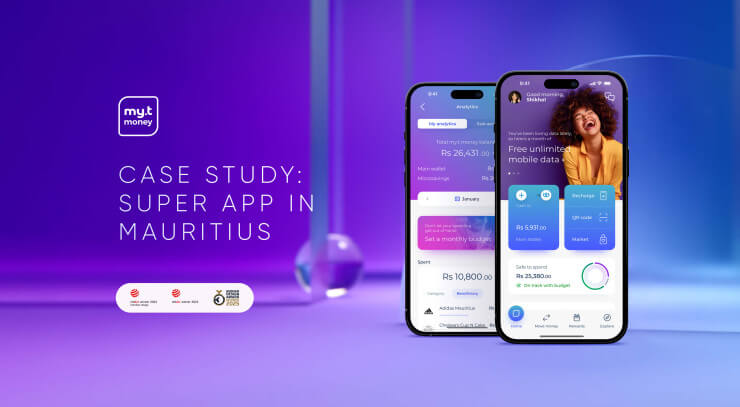It happens that a large team's tremendous efforts to design and develop a perfect financial app can be in vain upon its market launch, much like the huge Titanic colliding with an iceberg. A weak launch strategy results in a range of negative outcomes, including low adoption rates, poor customer experiences, high resistance and even reputational damage for financial companies. In this article, we'll explore key reasons why a digital product launch could fail and offer some tips on how to avoid these pitfalls.
A digital product launch strategy refers to the process of introducing a new or redesigned app to the market. This strategy involves a well-planned approach with a range of pre-launch, in-launch and post-launch activities that focus product team efforts on increasing customers' adoption and satisfaction rates through on-the-go product improvement based on feedback. The main goal of having a well-thought-through product launch strategy is to minimize the risk of the launched product's failure.
A well-planned and well-executed launch strategy greatly helps to create awareness about the product, address potential issues and build trust and credibility, thereby resulting in the delivery of a seamless customer experience, significantly reducing the chance of a digital product's failure. Without a strong launch strategy, even the most innovative and well-designed digital financial products may struggle to gain traction and achieve their full potential.
Big Losses Due to a Poor Launch
Of course, the biggest reason a product fails in the market is that it was created without the user in mind. But you can never be 100% sure that even a well-designed product will work as it should until it gets proof-tested by real users on a daily basis.
The impact of a poorly executed launch could be so huge that it could lead to product failure in the market. The key aspect that suffers is the users' trust in the product and the brand, leading to an abandonment of the product, switching to competitors, negative word of mouth and decreased engagement.
Consequently, this frustrating user experience directly affects the business and results in a number of potential negative and costly outcomes, such as spoiled brand reputation, loss of market share and inefficiently spent time and money. And, it will take a lot of effort to recover from these pitfalls.
Prior, during and after the launch, a comprehensive usability testing, capacity and technical debugging of the application is needed. If this and some other aspects are not properly executed, the reaction of users can be devastating for the product and the brand. In the case of a multi-million bank audience, the scale of consequences can multiply.
TSB Bank (UK) launched an app in 2018. Following TSB Bank's migration to a new banking platform, it has been difficult to stably cope with the high volume of its customers' traffic through digital products simultaneously. Throughout a five-day period, users suffered account lockouts and money missing from accounts as a result of post-launch issues. Some even had access to other users' accounts. The issues were so severe that the bank had to roll back its app to the old version, causing significant inconvenience for its customers, leading to additional losses of time, money and user trust.
According to a report commissioned and published by TSB, the bank’s Board failed to discuss the risks associated with a rapid new solution implementation. Additionally, no one consulted an external advisor for guidance. Because of this instant transformation, the consequences of the failure were felt by a million of its customers. The project team should have detected key pain points and system issues prior to go-live if TSB had used a more gradual approach. Even though it had conducted testing rounds, TSB acknowledged that they weren't done on a large enough scale.
The Financial Times noted that TSB’s IT problems have cost them £176m. The bank hired IBM two days after the crisis began to fix the issues with their new system that left thousands of customers unable to access their accounts. IBM later reported to the TSB Board that performance testing was inadequate, and no rigorous go-live criteria were applied for production readiness. This was revealed in a presentation published by Parliament's Treasury Select Committee.
Another example is Wells Fargo, a US-based bank, that encountered the consequences of comprehensive launch process neglect after its mobile banking app update in February 2022, which incorporated significant updates to its user interface and user experience. The release was met with widespread disapproval from users, significantly impacting their experience and engagement with the app.
The most severe effect of Wells Fargo's UI/UX update was on the overall ease of use, which suffered a decline of over 50%, particularly in relation to accessing a common banking app scenario of viewing transactions. The lack of user testing and validation of the updated app resulted in a drop in its rating from almost 4 points to 3.2 within a month, leading to loss of time, resources and customers due to diminished satisfaction with the app and loyalty to the brand.
Since then, Wells Fargo has been making consistent efforts to regain leading positions in the American banking sector. The company is continuously synchronizing with the users' expectations and demands, improving its mobile banking app user experience, and has managed to deliver an even stronger mobile banking experience, resulting in an impressive rating of 4.8.
Reality demonstrates that a digital financial product launch is a complex process that requires a significant amount of planning, execution and ongoing efforts to test, collect feedback and improve the product to ensure the best possible customer experience and long-term product success on the market.
Before we deep dive into the launch process mistakes, we should become aware of the important steps the success of a digital product depends on:
- Digital strategy - to define the product role and place in the company's mission, goal achievement and digital ecosystem development
- UX design - to ensure a product value that matches the business and customers’ needs
- UI design - to ensure a state-of-the-art look and feel that distinguishes the product in the market
- Development - to provide speed, functionality and security of the digital solution
- Marketing - to communicate product value and benefits and prepare the market
- Launch - to impact customers' adoption and feedback
- Support - to improve the product and serve its customers.
It is crucial to carefully approach each step above to mitigate the potential for product failure following its launch. These steps require the involvement of multiple teams with various fields of expertise, while, at the same time, all of them should be aligned regarding the ultimate goal of the product.
10 Deadly Mistakes During the Launch Process
When it comes to launching a digital financial product, mistakes can be particularly costly. Surely, there is large variety of mistakes that might occur during the steps mentioned above that can lead to failure, but let's take a look at the most critical ones that can ruin a launch:
1. Let's go all in
Launching a product for a whole audience at once is a significant risk, especially for redesigned products. It is better to launch it gradually by testing and collecting feedback in small and controlled customer groups.
2. Let's surprise the audience
Lack of product communication can increase resistance, demotivate users and lead to unnecessary frustration. Prepare your audience to support the product and help to improve it.
3. Users will get it
Even an intuitive product design can be hard to understand from the start, especially if it replaces the old version. Helpful onboarding tips will prevent customers from feeling lost and powerless.
4. Launch it yesterday
Courage is great, but with digital products it is better to take your time to test and check everything multiple times with the help of professionals.
5. Have no time to listen
Ignoring customers' feedback at the launch stage is not the best idea. On the contrary, we actually need to find the best way to get feedback, especially negative ones, in order to improve the product.
6. Our team is always ready
Great leaders trust their team, but they also make sure that everyone is ready for launch and clearly knows what to do, especially when something goes wrong.
7. Make it louder
Persistent and inconsistent promotion can provoke inadequate customer expectations. Apple's high-profile promotion is only possible with a perfect product development. At the same time, the lack of thoughtful marketing will lead to zero interest and lack of demand in the market.
8. Run what we have
If the launched product does not meet the minimal requirements and expectation of the users in terms of functionality and provided services, they may not get a second chance. Make sure you have the basic level established.
9. We have other priorities
If the company is not able to provide adequate and friendly customer support, users may have difficulty using the app or resolving any issues they encounter. This can lead to negative reviews, poor ratings and a loss of customer trust.
10. We like it raw
A product is not a beef steak, so technical shortcomings in financial apps can lead to complete customer dissatisfaction. Don't ignore long load times, lags, lack of instant status updates, downtimes, etc. In finance, it is necessary to provide a well-done product with stable technical performance.
How to Ensure a Strong Launch Strategy
Imagine that you are launching a rocket. If it blows up, there won't be a second chance. You need a detailed plan and a backup for emergencies.
To ensure a perfect launch execution, it's crucial to establish an alignment between the team and company members regarding the product’s goals, mission and value. Common understanding and synchronization within the team will assist to work toward reaching the set unified target.
The main focus of the strong launch strategy should be on matching customers’ requirements and ensuring a stable technical performance. This is the stage at which the most catastrophic failures happen.
A successful launch strategy can be divided into three stages: Pre-Launch, Launch and Post-Launch. Across all stages, there are five key processes that need to be managed: Planning, Testing, Collecting, Improving, Promoting and Supporting.
Planning
As a product launch foundation, the company should define a strategic plan designed to capture and consider all the aspects for an upcoming launch, including the approach and the timeline of tasks. Product launch planning will also help you prepare for the black swan cases, rollback plan and the integration of data tools.
Testing
It's important to test the developed product in a controlled environment to identify any potential issues and ensure that the product being developed meets the quality and regulatory requirements. Fixing issues after launch is often more time-consuming and costly than fixing them before launch.
Pre-launch testing should include complete QA (quality assurance) and UX testing, which includes the system and design evaluation of the product, and also the user acceptance testing to validate end-to-end business flow with real-world scenarios.
Global experienced companies almost always follow a strategy of careful and gradual increase of the pool of users who the released product becomes available for. Such an approach helps them to identify potential issues early on and avoid a negative user experience spreading among a significant portion of the product's users. This step-by-step approach can also provide valuable feedback for product improvements and help businesses manage resources.
Collecting
Both during the pre-launch phase and after releasing the product, it's important to gather usage and behavioral feedback from a diverse group of users, as well as from the in-app and system data. This will help to identify areas for improvement and ensure that the product meets the needs of its target audience. User feedback will validate the hypotheses set for the product creation, reduce inefficiency and incapability of the product and provide valuable and accurate solutions to customers' problems.
Improving
It's important to continuously monitor and improve products based on the user feedback and observations of the system. This will ensure that the product remains relevant and valuable to users over time. Regular testing ensures the ability to execute cost-effective and rapid releases. With feedback and goals in hand, the improvements that will have the biggest impact on your users and your business must be prioritized.
Promoting
A comprehensive launch strategy should also include an accurate all-inclusive marketing and promotion plan, which identifies target audiences, creates compelling messaging and uses the right channels to reach users. A clear and transparent marketing approach that highlights the unique selling points and benefits of the product while avoiding any misleading information is crucial to creating a positive user experience for customers. By providing accurate information and setting realistic expectations, businesses can establish trust with their target audience and ultimately increase the likelihood of customer satisfaction and repeat business. After creating a loyal user base before the launch, the product’s quality will be the biggest marketing strategy.
Supporting
It's not just about developing and releasing the product but also about ensuring that customer support and technical teams are aware and ready to handle any issues that may arise after the launch. This means providing training, resources and tools to support the launch process and ensure that the product is well received by customers. It's also important for teams to be able to observe and monitor the product's performance, so they can make adjustments as necessary. With proper in-house readiness, a company can launch a successful digital product that meets the needs of its customers and supports its business goals.
Takeaway: Best UX is not Possible without an Effective Launch Strategy
It is crucial to invest the necessary time, effort and resources to mitigate the risk of failure, to implicate all the necessary product launch mechanisms and to ensure that users have a positive initial experience with the new digital product.
A comprehensive launch strategy, including pre-launch testing, gathering feedback, continuous improvement and effective marketing and promotion, is vital for a successful launch and ongoing success. By carefully planning and performing these steps, financial institutions can increase their chances of creating a digital product that meets the needs and expectations of their customers, becomes loved by them and stands the test of time.
In order to maximize the chance of delivering a truly satisfying product to the users, companies should not ignore the launch strategy. To achieve this, they can hire external experts to support and advise them to empower their digital product launch process.
That's why supporting the product launch and establishing a launch strategy is an important part of UXDA’s deliverables. We help our clients with various aspects of launching a digital product, including user experience testing, pre-launch planning and team synchronization, promotion materials preparation and post-launch UX analysis.
Our collected insights and guidance aim to optimize the process and launch well-designed digital products with confidence, knowing that they have met the highest quality standards for UX through thorough testing and evaluation.
Get UXDA Research-Based White Paper "How to Win the Hearts of Digital Customers":
 If you want to create next-gen financial products to receive an exceptional competitive advantage in the digital age, contact us! With the power of financial UX design, we can help you turn your business into a beloved financial brand with a strong emotional connection with your clients, resulting in success, demand, and long-term customer loyalty.
If you want to create next-gen financial products to receive an exceptional competitive advantage in the digital age, contact us! With the power of financial UX design, we can help you turn your business into a beloved financial brand with a strong emotional connection with your clients, resulting in success, demand, and long-term customer loyalty.
- E-mail us at info@theuxda.com
- Chat with us in Whatsapp
- Send a direct message to UXDA's CEO Alex Kreger on Linkedin





















